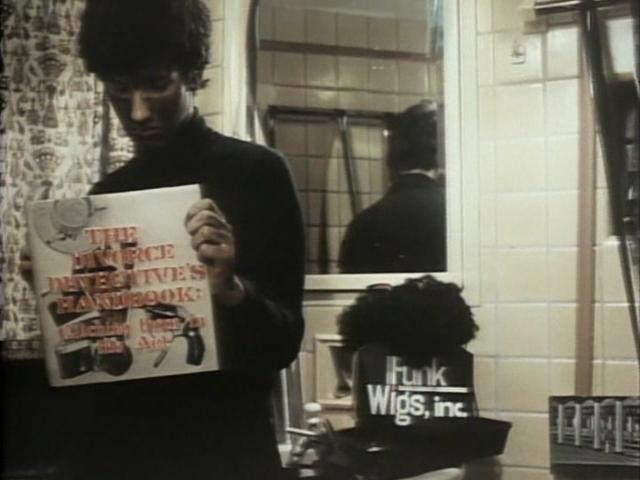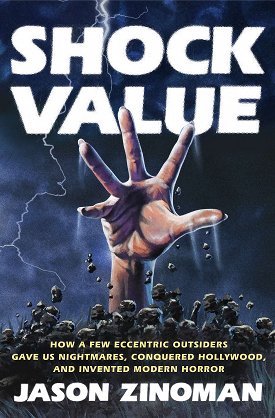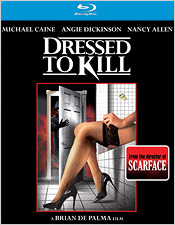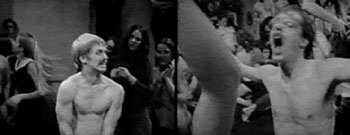UPDATE: NEW INTERVIEW WITH ZINOMAN AT COMPLEX

After getting my hands on a copy of Jason Zinoman's new book, Shock Value (see earlier post here), I immediately skipped to the chapter on Brian De Palma, which is titled "He Likes To Watch." This chapter makes the book an essential read for anybody interested in De Palma's work. The chapter is put together with the help of new interviews with De Palma, William Finley, Jared Martin, Nancy Allen, Keith Gordon (pictured here from De Palma's Home Movies), Betty Buckley, Amy Irving, Lawrence D. Cohen, Tina Shepard, and, if I'm not mistaken, Steven Spielberg, and perhaps Stephen King (having not read the entire book yet, I skimmed but could not find any official acknowledgment of who provided new interviews for the book, but based on the way they're worded, I'm pretty sure Zinoman uses a couple of brand new quotes from Spielberg).
In this chapter, De Palma says that he couldn't see before what he sees clearly now: that the reason his films repeatedly feauture a character who fails to save somebody is because that was how he felt when his little brother, Bart, was all torn up over their parents marital woes. De Palma helped his mother get a divorce by spying on and eventually catching his father in the middle of a tryst with his nurse (De Palma later called the photos he snapped his first film). But he could not save his brother from the pain of the situation. And it is De Palma who sees now that this is the source of the heroes' consistent plight in his own films.
Hence, Zinoman argues, De Palma's films are much more invested in autobiographical elements than most (critics and fans alike) have given them credit for, and he points out the irony that De Palma's most confessional film, Home Movies, is hidden as a zany comedy that hardly anyone has seen or even heard of. Zinoman goes so far as to show how De Palma himself relates to the character Kate Miller in Dressed To Kill. While it may be a stretch when Zinoman tries to link to the above De Palma narrative by suggesting that Kate is a character who tries to save herself from a dead-end marriage, he is spot on that Kate goes to the museum and does essentially what De Palma used to do at museums: pick up a member of the opposite sex. Zinoman concludes that, far from the usual misogynistic reading of Kate Miller (who has an adulterous affair and symbolically "pays for it" with her death), De Palma is quite sympathetic to the character. Zinoman stops there, but I would add that by designating Kate's son, Peter (again played by Gordon), as De Palma's obvious surrogate in the film, the sympathy toward Kate is corroborated.
The chapter's main focus is on De Palma's Carrie adaptation, although Zinoman nicely leads up to that film by moving from the aforementioned divorce story, through De Palma's formative college years, and his early film work. Through descriptive passages, Zinoman relates how an experience De Palma had while sitting in the audience at a performance of Dionysus In ‘69, which he was preparing to film in split-screen, led to an idea for the key prom sequence in Carrie. Zinoman also delves into how the film departed from King’s novel, and a volley between Buckley and Irving over which of their characters should survive Carrie’s massacre (throughout filming, it was not known who would be the one to survive).
All in all, a terrific chapter full of new information that fills in some major pieces of the De Palma puzzle. I said that this book is essential to any research on De Palma, and in that respect, I would put it on a shelf along with The Film Director As Superstar by Joseph Gelmis, The Movie Brats by Michael Pye and Lynda Myles, Brian De Palma by Michael Bliss, The De Palma Cut by Laurent Bouzereau, Double De Palma by Susan Dworkin, The Devil’s Candy by Julie Salamon, Brian De Palma: Interviews, edited by Laurence F. Knapp, Brian De Palma, entretiens avec Samuel Blumenfeld and Laurent Vachaud, and Les mille yeux de Brian De Palma by Luc Lagier. There are other great books out there that feature insightful analyses of De Palma’s work, but the books mentioned above include interviews and provide priceless bits of information useful to anyone studying the films of Brian De Palma.
UPDATE: ZINOMAN SOUGHT OUT INTVS WITH THE PEOPLE WHO KNEW THEM BEFORE THEY WERE FAMOUS
Today (Monday, July 11 2011) Complex posted Matt Barone's interview with Zinoman, who says he wanted to get the stories behind these films that haven't been told before:
The biggest challenge for me, though, was…. There’s a really excellent and dedicated sect of horror press that covers every single one of these movies all the time. There are so many wonderful blogs, and, seeing the response to my book, it’s hard not to be impressed by how smart all these people are. So one of the biggest challenges was: Wes Craven has been interviewed thousands of times, so how do you get him to recreate what it was actually like in the early ’70s to make The Last House On The Left, in a way so that it’s not him repeating the same stories that he’s told over and over again?
So, my goal with this book was to root it in reporting. There are definitely criticisms in it, and I have a strong point-of-view, but I wanted to really tell a story. I wanted it to read like a narrative, with these horror directors and writers as the main characters. and I wanted it to be rooted in original reporting. I found that spending long periods of time interviewing them was very helpful. Talking to a lot of people who don’t usually get interviewed was also key, like supporting actors, family members, people who went to school with these directors, childhood friends.
I tried to really look at sources from back in that time; I didn’t want to talk to people who are higher-level fans or made movies starting in the ’90s or later. I looked at it more as, “Who knew Brian De Palma before he was famous? Who went to college with him?”; Wes Craven’s wife from back before he made The Last House On The Left. Those people I found were excellent sources; they had firsthand knowledge of what was going on, that wasn’t informed by the fact that they’ve been telling the same stories for thirty years. Often times, I got a fresher perspective talking to those people, and once I talked to those people I went back to Craven and De Palma, joggled their memories with the stories I’d heard, and then I got all-new memories from these filmmakers.
Updated: Monday, July 11, 2011 7:19 PM CDT
Post Comment | View Comments (2) | Permalink | Share This Post




 A new book on modern horror films that officially comes out tomorrow (Thursday, July 7th) has been getting quite a bit of pre-release web publicity this week. In the book, Shock Value, New York Times writer Jason Zinoman looks at the way horror movies changed in the 1960s, moving through the early 1980s, and, according to reviews, blasts several myths about these films and their makers along the way (notably citing "the problem with Psycho," and how these filmmakers responded to that "problem"). See reviews from
A new book on modern horror films that officially comes out tomorrow (Thursday, July 7th) has been getting quite a bit of pre-release web publicity this week. In the book, Shock Value, New York Times writer Jason Zinoman looks at the way horror movies changed in the 1960s, moving through the early 1980s, and, according to reviews, blasts several myths about these films and their makers along the way (notably citing "the problem with Psycho," and how these filmmakers responded to that "problem"). See reviews from 


 September 6 will be a big day for De Palma fans who have a Blu-Ray player, as two early De Palma classics are released that day. FOX and MGM announced this past week that they will release Brian De Palma's Dressed To Kill on Blu-Ray September 6th, with all the same extras as the regular DVD a few years ago. Earlier this year, Universal announced its Scarface Blu-Ray, also for September 6th. Judging by the cover of Dressed To Kill, shown here, the Scarface date may have had a lot to do with FOX's strategy to release Dressed To Kill on the same date (re: "From the director of Scarface).
September 6 will be a big day for De Palma fans who have a Blu-Ray player, as two early De Palma classics are released that day. FOX and MGM announced this past week that they will release Brian De Palma's Dressed To Kill on Blu-Ray September 6th, with all the same extras as the regular DVD a few years ago. Earlier this year, Universal announced its Scarface Blu-Ray, also for September 6th. Judging by the cover of Dressed To Kill, shown here, the Scarface date may have had a lot to do with FOX's strategy to release Dressed To Kill on the same date (re: "From the director of Scarface).


 Alain Corneau's Love Crime is teasingly taut and seductively compelling in all the right places. The main tease comes in the form of a mystery wherein the viewer knows that the protagonist is up to something, and the film challenges us, dares us, to try to figure out what the details might be prior to the climactic comeuppance. While watching this film study of "the perfect crime," I wasn't reminded so much of Hitchcock's Dial M For Murder as I was of Kieślowski's Three Colors: White. In both films, the main character begins doing things that at first don't seem like much more than personal ways of coping with recent humiliation and lost love. Only as they keep going on does the viewer begin to realize that every detail of their behavior has been carefully, almost silently planned. This is perhaps a bit less so in Corneau's film, which, as I suggested above, delights in teasing the audience.
Alain Corneau's Love Crime is teasingly taut and seductively compelling in all the right places. The main tease comes in the form of a mystery wherein the viewer knows that the protagonist is up to something, and the film challenges us, dares us, to try to figure out what the details might be prior to the climactic comeuppance. While watching this film study of "the perfect crime," I wasn't reminded so much of Hitchcock's Dial M For Murder as I was of Kieślowski's Three Colors: White. In both films, the main character begins doing things that at first don't seem like much more than personal ways of coping with recent humiliation and lost love. Only as they keep going on does the viewer begin to realize that every detail of their behavior has been carefully, almost silently planned. This is perhaps a bit less so in Corneau's film, which, as I suggested above, delights in teasing the audience.